The Federation Heritage of Colac, Victoria
[Previous post: Art Nouveau in Malvern East ... Next post:]
Table of Contents
Colac is a peaceful town with plans to convert and use its heritage buildings for generations to come.
Colac displays a fine collection of Federation and Queen Anne architecture, with excellent examples of the most important styles. We are so fortunate in their high standard of preservation, and wish that more would be classified for preservation by the Victorian heritage authorities.
This flowering of Federation Queen Anne style was mostly a residential style established in the 1890s boom, which was inspired by the work of famous architect Richard Norman Shaw, and by the Arts and Crafts movement in England, but also encompassed some of the more stylised elements of Art Nouveau, which gave it a more decorative look.

Most of the older Colac area homesteads were designed by architects Davidson and Henderson, who were tutored mostly in Gothic Revival designs and were influenced by the French Romanesque. This, in combination with the considerable input of their clients, has produced a curious and engaging blend of masses and patterns.
This post was inspired by the photostream of raaen99 on flickr for which I am very grateful.
Other information is from Heritage Victoria and Colac Community website. Thanks to all.
Colac
 |
| Road map |

- Colac is a small city in the Western District of Victoria, Australia, approximately 150 kilometres south-west of Melbourne on the southern shore of Lake Colac and the surrounding volcanic plains, approximately 40 km inland from Bass Strait. (Wikipedia)
Historic Colac is on the inland route to the Great Ocean Road and the famous 12 Apostles and experiences a relaxed country lifestyle. - Situated on the shores of Lake Colac and on the doorstep of the Great Otway National Park, Colac is a lively regional centre close to some of Victoria's most-loved natural attractions.
- Located around 148 kilometres west of Melbourne, Colac (population 14,500) is the commercial centre for the surrounding pastoral, agricultural and dairying region.
- Pastoral pursuits have been the mainstay of this area’s economy since it was first settled by Hugh Murray in 1837, the same year that explorers Joseph Gellibrand and George Hesse disappeared while exploring the district. Colac’s main street takes its name from that of its first European settler.
 |
| Swans on Lake Colac |
An early European visitor to the area was novelist Rolf Boldrewood (nee Thomas Alexander Browne) who, in Old Melbourne Memories (1884), recalls visiting Lake Colac in 1843 and finding it full of wild ducks, geese and cranes.
- 'It was a scene of surpassing beauty and rural loveliness...This Colac country was the finest, the richest as to soil and pasture that I had up to that time ever looked on'. His son bought a local property in 1885, there entertaining his father and guests such as Dame Nellie Melba.[1]
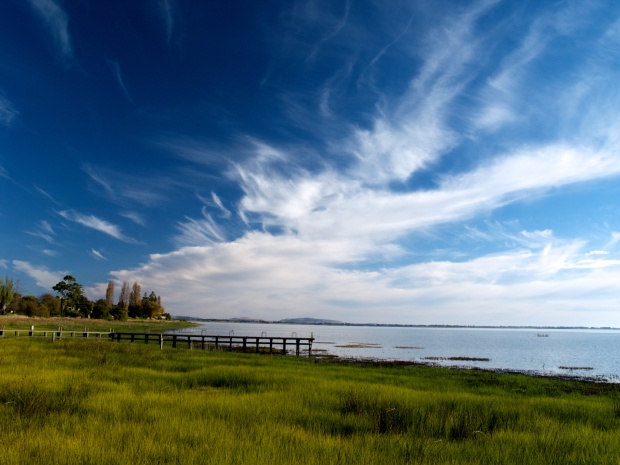
Lake Colac
Murray, along with pastoralists William Robertson, Alexander Dennis and John Calvert all established large runs in the area, complete with substantial homesteads, some of which still exist today.
- Some significant contributions to sheep-farming were made by these early settlers. Dennis produced the first Polwarth sheep by cross breading Merinos and Lincolns, while Calvert produced the Dreeite-Cotswold breed.
- The plains around Colac are the third largest volcanic plain in the world.
- The stone walls of the area were constructed, in part, as a barrier to prevent their further spread. In 1871 a rabbit canning factory was constructed and its produce exported to the UK. In 1880, with the passing of the First Rabbit Act, the destruction of rabbits on each property was made the landholder's responsibility.
Robertson, James (1848–1890)
William Robertson purchased the rights to 5000 acres at Colac in 1837. The Robertson estate at Colac was without exception the finest estate in one block in Victoria. After the death of Mr. William Robertson his four sons entered into partnership, which continued for a number of years, the business being under Mr. James Robertson's management.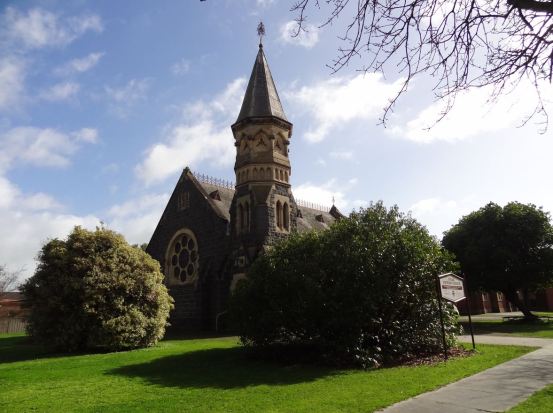
- James Robertson was acknowledged to be the best judge of Shorthorns in Victoria as well as being a thoroughly practical farmer, and it is not therefore surprising that the firm were most successful breeders of this type of cattle.
- He was one of' the most popular men in Victoria, and he did more than probably anyone else for the Colac district.
- A few years after this the firm dissolved its partnership, and a large area of this land was sold by auction. Mr. James Robertson's portion averaged £21 per acre, and a large quantity was leased for agricultural and grazing purposes, the former averaging £2 3s. per acre and the latter 20s.[2]
- The rose shape window was erected in 1877 and is dedicated to the memory of the pioneer of the Colac district, William Robertson, who died in 1874.
- The primary window, the large series of round stained glass windows in the liturgical east end, is an eight lobed oculus, or more commonly described as a wheel or rose window, and measures approximately 12 feet in diameter.
Colac Heritage Walk
The Colac Heritage Walk takes in the architecture and history of many buildings around town including churches and the railway station.Further information and maps are available at the local visitor information centre: Corner Murray Street (Princes Highway) and Queen Street, (03) 5231 3730
|
|
|
|
Botanic Gardens
Colac Botanic Gardens are situated on the southern shore of Lake Colac. The land was set aside for that purpose in 1865 but plans were not prepared until 1910 by William Robert Guilfoyle, the director of the Melbourne Botanic Gardens.
- Covering 15 ha they contain over 1000 specimens (more species than any other provincial garden in Victoria), including trees registered by the National Trust.
- There are also shady picnic areas with barbecue facilities and a children's playground, a loop drive for motorists, as well as a network of walking paths for pedestrians.
- The main entrance, with its ornate iron gates, is at the end of Gellibrand St. They are open from 7.00 a.m. to 6.00 p.m. in winter, extended to 8.00 p.m. during daylight savings.
Read more:
- Two of William Guilfoyle's finest Western District private gardens at the twin properties of Mooleric and Turkeith near Birregurra.
- Each complementing a bluestone homestead, the gardens feature the characteristics of Guilfoyle's style –
- picturesque vistas, sweeping lawns, winding pathways, exotic plantings and colourful shrubberies.
'Balnagowan'
3-21 Stodart Street, COLAC| BalnagowanBalnagowan was built on Lake Colac in 1892 for grazier Alexander Fraser Ross, a grand residence with elements of the Queen Anne/Elizabethan style. The interior retains much of its original splendour including solid walnut doors, Kauri pine parquetry floors, a stately entrance foyer with magnificent walnut staircase and fine leadlight windows. The property is being developed as a retirement village with the restored Balnagowan as its centrepiece. Developers of Colac’s Balnagowan House say the city will benefit from a $14-million redevelopment of the historic mansion.. |
| |||
| Box Hill company is mansion’s new owner THE Colac Herald can reveal a Box Hill-based company owns Colac’s iconic  Balnagowan House.
The Colac Herald left a message with Ms Rich yesterday and she failed to respond.
| The property was abandoned and became overgrown and dilapidated, making it a target for crime and arson attacks.
Updated The Colac-Otway Council has won an order from the Victorian Civil and Administrative Tribunal (VCAT) to enforce the protection of a historic mansion near Colac.
|
Jennifer Chiu, Wednesday, May 9th, 2012.
Balnagowan’s owners Leigh and Jan Rich are working with Coast and Country Villages, and Valyarra to transform the 121-year-old
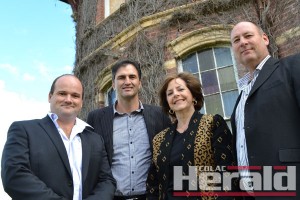 |
| Balnagowan House developers Jason Chivers and Andrew Wyatt, Coast and Country Villages director Susan Malone and Balnagowan owner Leigh Rich. |
- Mr Rich, Valyarra builders Jason Chivers and Andrew Wyatt, and CCV director Susan Malone were in Colac this week to inspect the mansion and speak to Colac Otway Shire Council leaders.
- Mrs Malone said builders would begin the restoration within two weeks, fixing the building’s windows and exterior.
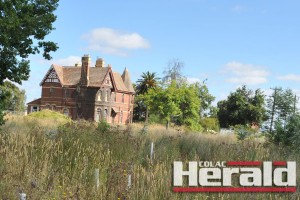 |
| Colac's historic Balnagowan Mansion |
“Then immediately after that, they’ll be working on the interior,” she said.
Mr Chivers said the renovations and units would cost about $14 million.
He said it was “inevitable” the project would involve Colac workers and he planned to finish the refurbishment by the end of the year.
“It’s a great country project, we’re looking forward to kicking it off and giving back to the community,” he said.
 |
| Historic Balnagowan Mansion has survived its third fire in as many months as news of the property's new owner emerges. |
Mrs Malone said the development would mean “a substantial contribution to the area”.
“We’re keen to put money back into the community by hiring locals where we can.”
Mr Rich is also director of Melbourne’s Inwood Constructions and he will help restore Balnagowan with Valyarra’s builders.
- The mansion will include a lounge, bar, billiards room, library, guest suite, consulting room and conservatory.
- Vandals have broken windows, spraypainted walls and lit a fire in the mansion, which also has cracks and broken ceilings.
- “What we can save, we’ll save, and we will try to reproduce any areas that we can’t save,” Mrs Malone said. Read more
 |  |
 | 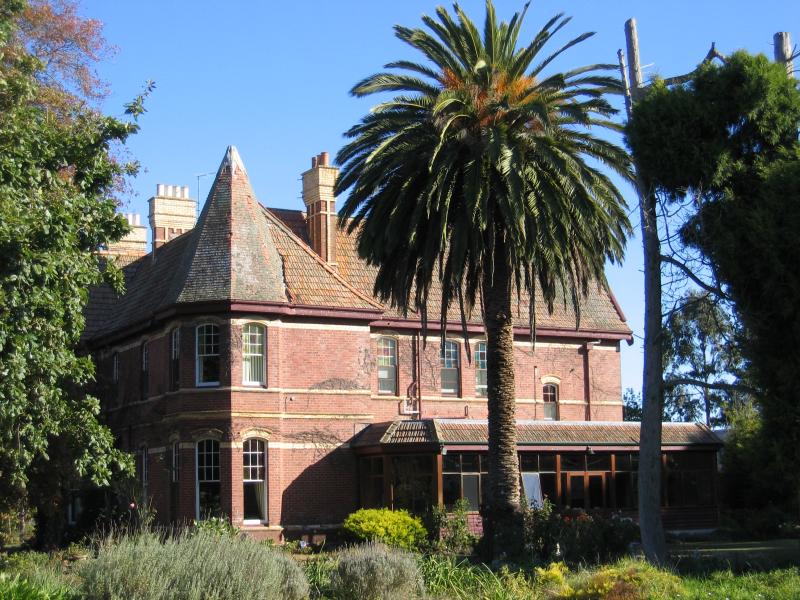 |
 |  |
'Thornbank'
Circa 185544 Moore Street COLAC (National Trust listed)
$750,000 to $840,000 (under offer)
 |  | |
 |  | |
 |  |
- "For all its grandeur, this National Trust listed home is light filled, warm and welcoming. Constructed of solid bluestone with a further brick and render extension in 1869, Thornbank will enchant you as it has the current owners for 40 years.
- Properties of this calibre are tightly held in Colac so this truly is a rare opportunity for you to embrace a new era in your family's life. There is everything to love about Thornbank. The sun soaked verandah just beckons you to enjoy your morning tea and boasts beautiful original iron lacework and terracotta and sandstone tiles.
- Step inside and discover multiple living areas that offer a room for every occasion and season. The Ballroom is without a doubt one of the most desirable rooms of the home with a commanding 16ft ceiling, open fireplace and stunning bay window. The other area in the house to captivate you is the kitchen, beautifully appointed and with delightful vistas of the garden.
 |
| Thornbank, Colac |
Thornbank
Moore Street, west Colac. Built in 1855–56 for Edward Bage, the District Surveyor who probably also designed the building, it is one of the oldest surviving houses in the area, now nestling inconspicuously in a ‘suburban’ streetscape. A single-storeyed building in the ‘Australian Colonial’ style, with English, Georgian and Gothic influences, its extensive verandahs have decorative fretwork and iron posts. Brick stables and groom’s quarters still exist, but the extensive gardens have been considerably reduced. A private residence, classified by the National Trust.Coragulac House
895 Lake Corangamite Road, Coragulac - STATELY BLUESTONE HOMESTEAD DATING FROM 1873 |
| 895 Lake Corangamite Road, Coragulac, Vic 3249 |
 |  |  |  |  |
 |  |  |  |  |
Pioneer and squatter named William Robertson acquired a large tract of country; he had four sons, William, John, George and James, and each son was placed on an estate — William getting "The Hill", John "Cororooke,", George "Coragulac" and James "Glen Alvie";
|  |
- that the land took in the whole of the Warrions and reached to the boundaries of the town of Colac, about 30,000 acres;
that the Robertson Bros. had an aristocratic herd of shorthorn cattle, all the males being Dukes and the females Duchesses of Derrimut, and that at the annual sales many of the animals brought over a thousand guineas and one or two even passed two thousand.
895 Lake Corangamite Road, Coragulac - This is history! The estates are now a thing of the past and the flourishing townships of Cororooke and Alvie have risen Phoenix-like from the ashes and the descendants of the pioneer are scattered far and wide.(Trove)
- Coragulac House contains 26 rooms, spread across more than 100 squares. Designed by influential architects of that era, Davidson & Cameron the residence forms a horseshoe, with a central courtyard. The property is introduced by bluestone steps leading to a wide veranda which leads to a beautiful formal reception hall, with barrel vaulted ceiling lined by cedar and intricate timber carvings.
- An impressive 3 metre fireplace with bronze fire surround features gilt dragons. A stunning cedar lined billiard room is provided with natural light courtesy of a coffin sky light encased with lead light panels. Panther head carvings protrude from timberwork below the sky light. The billiard table will remain in this room. The dining room features a beautiful bay window and a fireplace with cedar mantle incorporating carvings that depict gargoyles.
- In total the home includes more than 9 bedrooms, 3 living areas, 3 bathrooms, and 2 kitchens. For many years the residence has functioned as two separate homes and also includes a full cellar and a cool store room. This magnificent residence is a very comfortable home and has been partly restored, although more work will be required to fully restore it to its former glory. Set amongst gardens which include mature exotic trees and expansive lawns.
'Derrinook'
– Corner of Gellibrand and Manifold Streets, Colac- from photostream of raaen99
 |  |
 |  |
 |  |

Derrinook
On the corner of Gellibrand and Manifold Streets, Derrinook was built of timber in 1900 as a private hospital in the Early Federation style, with many elaborate, tall chimneys capped with ceramic chimney pots. One of the first buildings in Colac to employ electric lighting, it was converted after the second World War into self-contained flats."Derrinook” was originally built as a private hospital for Doctor William Henry Brown (1861 – 1926) in 1900.
Built in the Federation Queen Anne architectural style, “Derrinook” is, unusually for the style, built of timber. Federation Queen Anne architectural style, which was mostly a residential style which was inspired by the Arts and Crafts movement in England, but also encompassed some of the more stylised elements of Art Nouveau, which gave it a much more decorative look.
- Sprawling across a large block with two street frontages, “Derrinook” has a very complex roofline, a common trait of Federation Queen Anne buildings, aided by a large number of half timbered gables. The former private hospital also has some beautiful Art Nouveau stained glass windows.
- “Derrinook” has a number of “fish scale” pattern panels decorating its façade above the tall windows. “Fish scales” were very popular thanks to the worldwide craze for all things Japanese in the late Nineteenth and early Twentieth Centuries. “Derrinook” also features very sinewy Art Nouveau fretwork around its bay windows, along its verandahs and employed as decoration on the half timbered gables. This was also common amongst Federation Queen Anne buildings. However it is perhaps “Derrinook’s” many elaborate, tall chimneys capped with ceramic chimney pots where the prevailing, and then fashionable, Art Nouveau decorative style is most apparent.
- One of the first buildings in Colac to employ electric lighting, “Derrinook” was eventually superceded by the Colac Hospital as a place for medical treatment and recouperation. With the change in fortunes for so many during the Great Depression, “Derrinook” was converted into smaller self-contained flats in 1935 and remains private residences to this day.
Yeowarra, Former Yeo Homestead
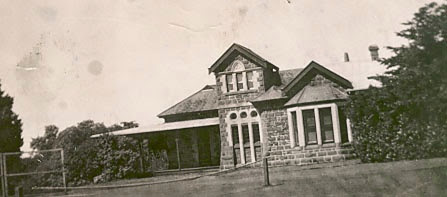 |  |
James Austin, an extremely wealthy pastoralist with extensive western district land holdings, was a celebrated Victorian pioneer and a Mayor of Geelong. He lived in retirement at Glastonbury Abbey, Somersetshire, from 1859-96. Yeo was built for his son John.
- Yeo is a large, single storeyed coursed bluestone residence, the main west front is asymmetrically composed, with the bay windowed dining room on the west side and the drawing room behind the verandah. It has a sidefacing front door in the base of the two storeyed, gable roofed tower with its triple windows. It has an unusual rounded corner detail or chamfer, round toplights and a pointed arch panel above. There is a notable coved ceiling in the dining room following the pitch of the roof. The roof is blue slate with a band of purple running horizontally about midway.
- Yeo homestead is a manifestation of success and vast disposable wealth accumulated by a successful family of nineteenth century pastoralists. It epitomises a degree of affluence that today would be regarded as a lavish and eccentric excess (Criterion B.2).
- The homestead is a fine example of the work of Alexander Davidson and George Henderson who had designed a large number of western district homesteads, including Barwon Park, for James Austin's brother, Thomas. Yeo Homestead is extremely valuable as a major example of the work of this partnership of Scottish trained architects.
- The homestead is also important for its associations with the Austin family who became well known in the area. James Austin was an alderman on the first town council of Geelong and later became the town's second Mayor.
- The Yeo homestead's architects, Davidson and Henderson, were tutored mostly in Gothic Revival designs and were influenced by the French Romanesque. This, in combination with the considerable input of their clients, has produced a curious and engaging blend of masses and patterns. Yeo homestead is well integrated into its William Guilfoyle designed landscape. This context is especially important for aspects that include the homestead's main elevations.
'Glenora'
- Corner Bromfield and Corangamite Streets, Colac- from photostream of raaen99
 |  | ||
 |  | ||
 |  | ||
 |  |
- “Glenora”, like its neighbor “Lislea House” on the opposite corner was built for use as a stylish residence and surgery, and “Glenora” has been constructed in the popular Federation Queen Anne style, which was mostly a residential style which was inspired by the Arts and Crafts movement in England, but also encompassed some of the more stylised elements of Art Nouveau, which gave it an more decorative look.
- By 1907 when “Glenora” was built, Federation Queen Anne was the prevailing style of fashionable architecture, and as a representation of Doctor Gibb’s success and prestige, the house could not have been built in any other style. Designed by successful local Camperdown architect Warburton Pierre (Perry) Knights (1872 – 1954) “Glenora” is a splendid example of this architectural movement. It has a very complex roofline, ornate stylized Art Nouveau wooden fretwork along both the upper and lower return verandah, half timbered gables, Art Nouveau mouldings around some of the windows and along the underside of some of the bay windows, and perhaps most striking of all, a beautiful rounded Art Nouveau entranceway to the surgery, complete with panels of ornate stylised stained glass.
Glen Alvie. Colac
 |
| Glen Alvie. Colac |
Geelong Advertiser 4 March 1874
Geelong Advertiser 7 June 1875
Geelong Advertiser 28 October 1875
- Designed by Scottish architect George Henderson who left to emigrate to Australia, arriving in May 1867 and joining the office of his former fellow assistant in his father's office, Alexander Davidson in Rokewood, Victoria. At first he acted as an unpaid associate to Davidson, though before long both Henderson and Davidson were able to send money home to assist their respective families, a number of large commissions coming their way in late 1868 and in early 1869 when the practice moved to Geelong in Victoria.
- Henderson largely fulfilled the role of office manager and was responsible for the costing of the jobs. It is unclear how much hand he had in design work. Only occasionally did he make site visits. In December 1875 he received an offer of work from William Hay, a former assistant of his father's who had returned to Edinburgh after a very successful; career in Toronto and the Davidson-Henderson partnership was terminated on less than friendly terms in April 1876, Henderson sailing home later that year. A partnership with Hay officially began in the following year. Like his father's it attracted both episcopal and presbyterian clients.[5]
'Lislea House'
- Corner Bromfield and Corangamite Streets, Colac- from photostream of raaen99
 |  | ||
 |  |
"Lislea House" was built for Doctor Wynne, a local practitioner, for his use as a stylish residence and surgery. "Lislea House" has been constructed in the popular Federation Queen Anne style, which was mostly a residential style established in the 1890s which was inspired by the Arts and Crafts movement in England, but also encompassed some of the more stylised elements of Art Nouveau, which gave it an more decorative look. "Lislea House" has a very complex roofline, which is typical of the Federation Queen Anne architectural movement, as is the steeply pitched roof, ornate wooden fretwork that graces the return verandah and the exaggerated height of the chimneys.
Mooleric Homestead
Woolshed & GardenA bluestone homestead and woolshed built in 1871 for Hon James Ford Strachan, with substantial two-storey additions of 1923.
 |  |
 |  |
- The homestead is an unusual combination of an 1871 single storey bluestone main body and a 1923 bluestone double storey wing with corner bay window which was placed to both be a feature of the garden, and command a view of the garden. Further brick additions containing a schoolroom were built at the rear in 1932. A bluestone woolshed and cottage are located about 1km east of the homestead.
- The garden illustrates the aspirations of the designed and owner in the 1900s. Guilfoyle brought plants with him on his several visits to Mooleric and is said to have called this his best small garden. A winding driveway gives glimpses into different sections of the garden and leads to a gravel forecourt in front of the house. The main garden consists of sweeping lawns bordered by dense shrubberies.
- Palms are used as feature plants and a curvilinear perimeter path leads through wire arbours set in rockeries on either side of the drive. A vista extends from the drawing room over low shrubs to a view of the Otway Ranges. A kitchen garden of over 0.5ha located to the north of the house is partly maintained.
- The garden reflects the lifestyle and tastes of the wealthy squatters in the western district and of the Ramsay family who have owned the property since 1899. A large kitchen garden to the north of the house is partly maintained.[6]
- Brian Stevens said he and other workers were in the homestead’s garden when they saw a “big plume of smoke”.
- “We were very, very lucky when they turned up when they did,” Mr Stevens said of firefighters.
“It got right up to the homestead.”
Mr Stevens said the homestead’s staff prevented the fire from spreading into 300 hay bales close to the home.
Federation Queen Anne Villa - Colac
- from photostream of raaen99
Built around the turn of the Twentieth Century, this villa has been built in the Queen Anne style, which was mostly a residential style inspired by the Arts and Crafts movement in England, but also encompassed some of the more stylised elements of Art Nouveau, which gave it an more decorative look. The weatherboard from which the villa is built, the shingling of the dominant gable and the awning that rund across the facade are all in keeping with the Arts and Crafts movement. Yet the stylised stained glass windows and door panels, ornate chimneys and the fretwork around the enclosed porch are very Art Nouveau in design.
Queen Anne style was most popular around the time of Federation. With complex roofline structures, ornamental towers of unusual proportions and undulating facades, many Queen Anne houses fell out of fashion at the beginning of the modern era, and were demolished.
Former Dental Surgery of Doctor L. C. Bayer
- Corner Gellibrand and Dennis Streets, Colac- from photostream of raaen99
 |  |
 |  |
Like other prominent buildings around Colac owned by the professional classes, such as “Glenora” and “Lislea House”, this building served two purposes; it was built for use as a stylish residence for Doctor Bayer as well as his dental surgery. The house, believed to be first brick veneer house built in Colac, has been constructed in the popular Federation Queen Anne style, which was mostly a residential style which was inspired by the Arts and Crafts movement in England, but also encompassed some of the more stylised elements of Art Nouveau, which gave it an more decorative look. It has a very complex roofline, including a splendid corner bay window topped by an ornamental tower, half timbered gables, stylised Art Nouveau panels of stained glass in both the windows and doors and exaggerated chimneys with ornamental detailing.
Former Presbyterian Manse - Colac
- from photostream of raaen99 |  |
Elegant in its proportions, this red brick building crosses two very different popular architectural styles. The former Presbyterian Manse is typically Victorian in shape, with a central front door and a beautiful return bull-nosed verandah of corrugated iron on the main street façade with a bedroom wing on the quieter side street façade. The arched windows of the former Presbyterian Manse are also very Victorian in style; large and arched. Yet it also has features of the Arts and Crafts movement, such as the choice of red brick for the construction and the roughcast treatment of the walls under the gables. It also features Art Nouveau fretwork along the verandah, panels of Art Nouveau stained glass in the front door, and the tall chimneys that are typical of the Federation Queen Anne architectural movement of the early Twentieth Century.
Former Parish Hall and Kindergarten
of St. John the Baptist and St. John the Evangelist – Pollack Street, Colac- from photostream of raaen99
 |  |
 |  |
The Church of St. John the Baptist and St. John the Evangelist was added to by Louis Reginald Williams in 1933. As part of that, an Arts and Crafts style Parish Hall and Kindergarten Room were added next to the church, using funds raised by local parishioner Esther Walton and the Young Helpers League. The building is very domestic in style, and is built from locally produced brown clinker bricks. The shingling on the bargeboards, the brick and stone detailing, and the windows of muted blue and yellow glass are all typical of the Arts and Crafts movement, as is the round front door. Louis Williams loved designing in the Arts and Crafts style, and was equally enthusiastic about Gothic architecture, so the hall features a small amount of detailed gothic detailing which seems somewhat at odds to the rest of the building’s uncluttered design."
Indicative places
8 Calvert Street Colac Vic 3250
 |  |
 |  |
 |  |
35 Queen Street COLAC
 |  |
 |  |
Colac & District Family History Group Inc
Its collection includes microfiche, a large genealogical book library, school records, church records, maps, cemetery indexes, various local files, CD ROMs and back-copies of more than 70 newsletters pertaining to other family history and genealogical groups.- The resources are held at the History Centre at C.O.P.A.C.C. in Gellibrand Street, Colac.
- Publications: 'COLADJINS' quarterly newsletter. Books for sale include 'The Colac & District Pioneer Register Pre 1900' and 'The Colac and District Pioneers' and Settlers Register, Volume 2, Pre 1920'.
- Events: A family history seminar is held annually in October; there is an annual Trivia night; and trips to places of genealogical interest are held throughout the year.[7]
Colac Community Website
- ^ http://www.smh.com.au/news/Victoria/Colac/2005/02/17/1108500206340.html
- ^ http://oa.anu.edu.au/obituary/robertson-james-15955
- ^ http://www.colacherald.com.au/2012/01/another-fire-and-owner-for-balnagowan/
- ^ http://www.abc.net.au/news/2010-11-01/vcat-orders-better-balnagowan-protection/2318894
- ^ http://www.scottisharchitects.org.uk/architect_full.php?id=201140
- ^ http://www.environment.gov.au/cgi-bin/ahdb/search.pl?mode=place_detail;place_id=18070
- ^ http://www.heritageaustralia.com.au/search.php?state=VIC®ion=75&view=220

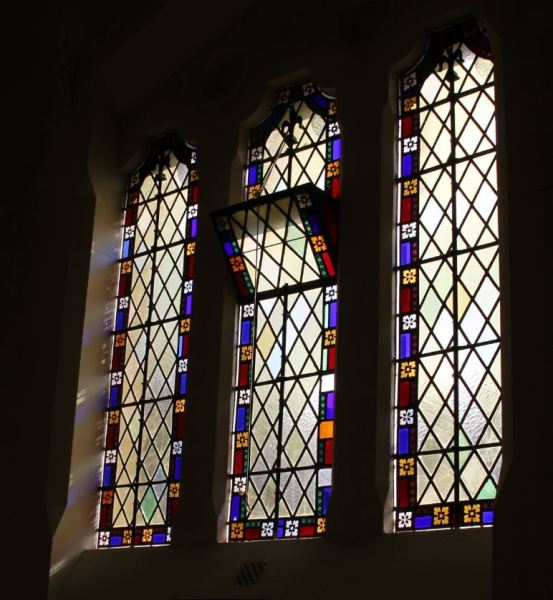
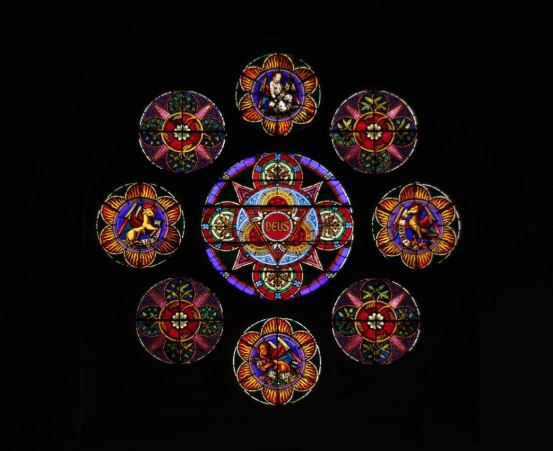







No comments:
Post a Comment